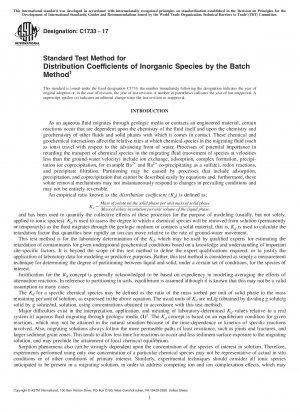ASTM C1733-17
Standard Test Method for Distribution Coefficients of Inorganic Species by the Batch Method
- Standard No.
- ASTM C1733-17
- Release Date
- 2017
- Published By
- American Society for Testing and Materials (ASTM)
- Status
- Replace By
- ASTM C1733-17a
- Latest
- ASTM C1733-21
- Scope
-
4.1 The distribution coefficient, Kd, is an experimentally determined ratio quantifying the distribution of a chemical species between a given fluid and solid material sample under certain conditions, including the attainment of constant aqueous concentrations of the species of interest. The Kd concept is used in mass transport modeling, for example, to assess the degree to which the movement of a species will be delayed by interactions with the local geomedium as the solution migrates through the geosphere under a given set of underground geochemical conditions (pH, temperature, ionic strength, etc.). The retardation factor (Rf) is the ratio of the velocity of the groundwater divided by the velocity of the contaminant, which can be expressed as:

where:
ρb = bulk density of the porous medium (mass/length 3) and ηe = effective porosity of the medium (unitless) expressed as a decimal. 4.2 Because of the sensitivity of Kd to site specific conditions and materials, the use of literature derived Kd values is strongly discouraged. For applications other than transport modeling, batch Kd measurements also may be used, for example, for parametric studies of the effects of changing chemical conditions and of mechanisms related to the interactions of fluids with solid material.
1.1 This test method covers the determination of distribution coefficients, Kd, of chemical species to quantify uptake onto solid materials by a batch sorption technique. It is a laboratory method primarily intended to assess sorption of dissolved ionic species subject to migration through pores and interstices of site specific geomedia, or other solid material. It may also be applied to other materials such as manufactured adsorption media and construction materials. Application of the results to long-term field behavior is not addressed in this method. Kd for radionuclides in selected geomedia or other solid materials are commonly determined for the purpose of assessing potential migratory behavior of contaminants in the subsurface of contaminated sites and out of a waste form and in the surface of waste disposal facilities. This test method is also applicable to studies for parametric studies of the variables and mechanisms which contribute to the measured
ASTM C1733-17 Referenced Document
- ASTM D1293 Standard Test Methods for pH of Water
- ASTM D2216 Standard Test Method for Laboratory Determination of Water (Moisture) Content of Soil and Rock by Mass
- ASTM D2217 Standard Practice for Wet Preparation of Soil Samples for Particle-Size Analysis and Determination of Soil Constants
- ASTM D2488 Recommended Practice for Description Of Soils (Visual-Manual Procedure)
- ASTM D3370 Standard Practices for Sampling Water from Closed Conduits
- ASTM D422 Standard Test Method for Particle-Size Analysis of Soils
- ASTM D4319 Standard Test Method for Distribution Ratios by the Short-Term Batch Method (Withdrawn 2007)
- ASTM D4448 Standard Guide for Sampling Ground-Water Monitoring Wells
- ASTM D5730 Standard Guide for Site Characterization for Environmental Purposes With Emphasis on Soil, Rock, the Vadose Zone and Ground Water
ASTM C1733-17 history
- 2021 ASTM C1733-21 Standard Test Method for Distribution Coefficients of Inorganic Species by Batch Method
- 2020 ASTM C1733-20 Standard Test Method for Distribution Coefficients of Inorganic Species by Batch Method
- 2017 ASTM C1733-17a Standard Test Method for Distribution Coefficients of Inorganic Species by the Batch Method
- 2017 ASTM C1733-17 Standard Test Method for Distribution Coefficients of Inorganic Species by the Batch Method
- 2010 ASTM C1733-10 Standard Test Method for Distribution Coefficients of Inorganic Species by the Batch Method

Copyright ©2024 All Rights Reserved